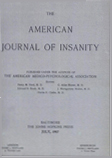Abstract
A psychosomatic approach should characterize every medical history. The general physician who gives to his routine history and examination a focus and scope such as that here outlined, will save himself considerable bewilderment and many errors. If he does so it should be in so far as possible with use of a method like that here suggested with an attempt to evaluate the clues so obtained. His success will depend to a considerable degree on his undergraduate and graduate psychiatric training. Here, as in abdominal palpation, much experience is required for development of touch and of ability to learn from it.
The general physician has been seriously hampered by the lack of adequate means of estimating the psychic component of the illness with which he is dealing. The psychiatric examination, even if he has been acquainted with it in medical school, is inadequate as just indicated, and also clumsy and time consuming. It is as unsuitable for office use as were many procedures for blood analysis when first discovered. Now some of the more fundamental of these can be carried out quickly with a few drops of blood and with sufficient accuracy to serve as a guide. This is the more important in view of the additional responsibility with which the general physician will be confronted as medicine is called upon to deal with social problems such as health insurance. It is interesting for example, that the panel physician in England is already being urged to equip himself with at least rudimentary psychiatric knowledge.
The material given as additional diagnostic aids the general physician can use only partially, and probably for his purposes these points should be observed merely as additional clues. The difficulties in the way of his adequate evaluation of a psychosomatic history are as follows:
First, the most valuable information is that given by the patient spontaneously, and the general physician often has neither the time nor the skill to obtain such information. He can however, give special attention to what happens to be given, bearing in mind the importance of avoiding the type of comment that would lead the patient to suspect that he takes any particular attitude towards what is said, other than that of the interested listener.
Second, spontaneous statements, associations, dreams and gestures have a significance to the psychiatrist in terms of the patient's personality strueture, repressed conflicts, and all that lies below the level of consciousness, which they can never have to the general physician just as is the case with neurological signs of cerebral injury, only the most obvious of which the general physician has either the training or the constant experience to recognize or evaluate.
Third, the general physician (whether he be a member of a general hospital staff, a family physician, or attached to some social group such as an insurance company or factory), is usually associated with discipline and is somewhat in the position of a judge from whom the patient awaits the sentence: operation or no operation, confinement to bed or discharge. This in itself puts the patient more on his guard than he is with the psychiatric consultant.
Fourth, of all our diagnostic and therapeutic resources there is none more important in the psychosomatic field than the transference situation, and for its adequate understanding and use psychiatric training is essential.
Many points suggested could be incorporated in the general medical history, and it is hoped that in the course of time this will be done. Even these, however, may need to be evaluated by the psychiatrist and supplemented by such additional examination as only he can give. This is particularly true in the analysis and management of transference phenomena. It has been said that psychiatry is the oldest of the medical arts, and the youngest of the medical sciences. The scientific evaluation of the physicianpatient relationship has been a determining factor in opening the way for psychiatry to develop also as a science.

